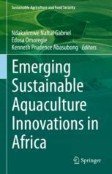Search
Search Results
-
Medicinal Plants in Tilapia Aquaculture
Tilapia are a group of fish belonging to the family Cichlidae. Because of their mild flavor and tasty flesh, tilapia has become the second most...
-
Tilapia Fish for Future Sustainable Aquaculture
Lately, aquaculture has been recognized as the fast-growing industry in the food production sector, and it requires maintainable development to cover...
-
Intestinal Microbiota of Tilapia: Characterization and Modulation
Tilapia (Oreochromis sp.) are cultured in many countries of the world. Its production is increasing from time to time to fulfill the demand for fish...
-
Novel Approaches Toward Sustainable Tilapia Aquaculture
The global human population will reach nine billion by 2050, and seafood is projected to be the primary food source to sustain such a large...

-
Diet-habitat ecology of invasive tilapia and native fish in a tropical river catchment following a tilapia invasion
Many species of tilapia (a collection of fish species from the cichlidae family) have biological traits that make them successful invaders....

-
Effects of Feed Additives on Tilapia Reproduction
Reproduction in fish is an energy-demanding process. The successful development of gonads requires adequate resources to sustain the high-energy...
-
Prebiotics and Synbiotics in Nile Tilapia Culture
With the increase in the human population, the need for protein-rich food is increasing. To cope with the increased demand for fish and fish-related...
-
Isolation and Identification of Pathogens from Fish: Tilapia Lake Virus (TiLV)
Tilapia cultivation is extremely profitable and the industry in India is rapidly expanding. China is the world’s largest producer of tilapia....
-
Alternative Protein Sources for Sustainable Tilapia Farming
During the past 20 years, there has been a growing concern about how best to replace fish meals with more sustainable, cost-effective, and...
-
Sustainable Tilapia Farming, the Role of Culture Systems
Considering environmental sustainability and vulnerability to the effects of climate change on fish production, sustainable and adaptable aquaculture...
-
Effects of omnivorous tilapia on phytoplankton and water quality in an ecosystem with submerged macrophytes
Nile tilapia [ Oreochromis niloticus (Linnaeus, 1758)] is a widespread invasive fish, now present in lakes, rivers, and reservoirs around the world,...

-
Nile tilapia and gilthead seabream dietary self-selection of alternative feeds
Classical assessments of new fish feeds are anthropocentric, focusing mainly on growth. Although this methodology is accurate, it does not consider...

-
An overview of parasitic co-infections in tilapia culture
Co-infection with pathogenic microorganisms has substantial harmful effects on susceptible host organisms. It may influence disease progression and...

-
Use of Plant Extracts to Control Reproduction in Tilapia Production Systems: An Emerging Eco-Friendly Innovation
This chapter gives an account of the usage of plant extracts to control-prolific spawning in tilapia production systems. The culture of mixed-sex...
-
Biofloc meal for tilapia feeding: growth and oxidative parameters
The biofloc system is a sustainable alternative for intensifying aquaculture production; however, in this production system there may be an excess of...
-
Meta-analyses indicate that dietary probiotics significantly improve growth, immune response, and disease resistance in tilapia
Aquaculture is expanding globally, but intensive rearing conditions can cause diseases due to microbial infections leading to financial losses....

-
Integrated system for bioremediation of Nile tilapia rearing effluent and astaxanthin production by Haematococcus pluvialis
Haematococcus pluvialis is a microalga that can reduce the levels of inorganic and organic components in effluents, in addition to production of the...

-
The inflammatory, genotoxicity, antioxidants, and pathological response to ectoparasite infection of cultured Nile tilapia
Ectoparasites Dactylogyrus spp. mainly infest fish gills and severely damage the host’s gill tissues. Correspondingly, the explanation of the...

-
Community structure of indigenous fishes relative to habitat variation and invasive tilapia in lakes of Quintana Roo, Mexico
Fish communities of tropical lakes are commonly predicted by local environmental variables, including depth, temperature, oxygen concentration, and...

-
Real-time glucose monitoring biosensor system assesses the effects of different environmental light colors on Nile tilapia stress response
Nile tilapia Oreochromis niloticus is an important aquaculture species worldwide, and understanding its behavior and growth performance under...

